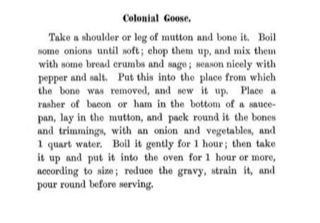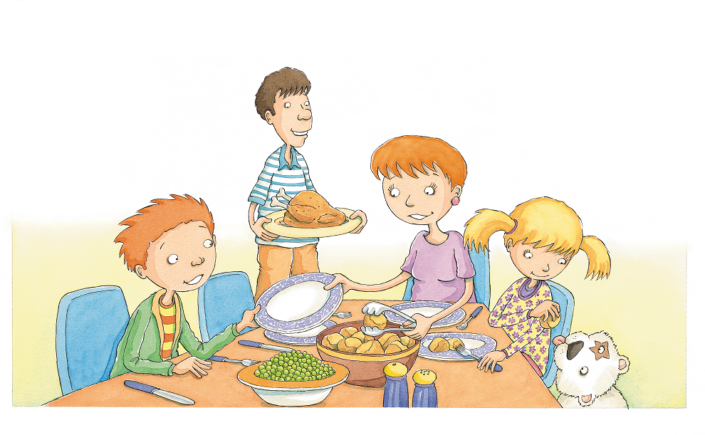By Bernadette Hince
First published in the April 2019 edition of Ozwords
‘Colonial goose’ — that rings a bell! In 1970s Melbourne, our typically Australian Anglo-Celtic family of the time went to mass every Sunday and came home to a family ‘roast dinner’ for lunch, almost always a leg of lamb. We all loved roast dinners.Things got even better when my mother and I discovered a recipe for colonial goose …which is not goose. It’s mutton or lamb, a boned and stuffed roast leg—easier to carve than an unboned leg (or a goose, for that matter), but more work. It usually includes a sage and onion-based stuffing—which is what you’d traditionally stuff a goose with.
Because my father sold old Australian books, my mother had an extraordinary collection of old Australian cookbooks. One of these, the Green and Gold Cookery Book, 16th edition (ca 1941) gives a recipe for ‘mock duck’—it’s a leg of boned mutton, and it’s exactly what other cookbooks call ‘colonial goose’. But my family used a recipe from a 1973 English cooking magazine series, Good Housekeeping, which had a full-page shot of a gleaming leg of lamb—‘colonial goose, step by step … a New Zealand classic’. Boned lamb is marinaded overnight in red wine and vegetables, giving a tender roast with a flavoursome gravy. Boning the leg creates a neat pocket for the stuffing, and this stuffing has dried apricots in it. Yum.
Labelling it ‘Austral. and New Zealand’, the Oxford English Dictionary (OED) defines colonial goose as a boned leg of mutton stuffed with sage and onions. This is pretty close to our 1970s dish in Melbourne, and it’s a definition lifted straight from the second OED quotation, which is from E.E. Morris’s 1898 Australian English. The only other OED quotation is
from Sarah Amelia Courage’s Lights and Shadows of Colonial Life,
published in New Zealand in 1897. Courage, a settler on New Zealand’s
Canterbury Plains, writes: ‘I .. declined it .. and also “Colonial goose”, and
bullock’s heart.’ Colonial goose appears in New Zealand cookbooks till at least the late 1950s (Aunt Daisy’s Ultimate Cookery Book). So New Zealand’s claim to the dish might—as with pavlova—look stronger than Australia’s. However, it’s not the whole story. There is earlier Australian evidence of the dish under this name. It is in the 1888 Kingswood Cookery Book by domestic economy instructor H.F. Wicken, ‘Diplomée of the National Training School for Cookery’. I guess you could say colonial goose is a genuine Kwaussie.
Colonial goose can be cooked in three different ways: done gently on the stove at first and finished off in the oven; pot-roasted from start to finish (in a pot roast, the meat is browned and then cooked, covered, on the stovetop, usually with added liquid); or oven-roasted after marinading. Wicken does it the first way, using the mutton trimmings and bone, and adding ham or bacon for extra flavour. She instructs: ‘Boil it gently for 1 hour; then take it up and put it into the oven for 1 hour or more.’ As Lauren Samuelsson says in her Ozwords article, some modern recipes claim that the point of boning and stuffing is to make the leg of lamb look like goose. Who would ever be fooled into thinking that a leg of lamb, even a boned one, looks remotely like a goose? But marinading and stuffing it does change the taste. Try it.


Leave a Reply